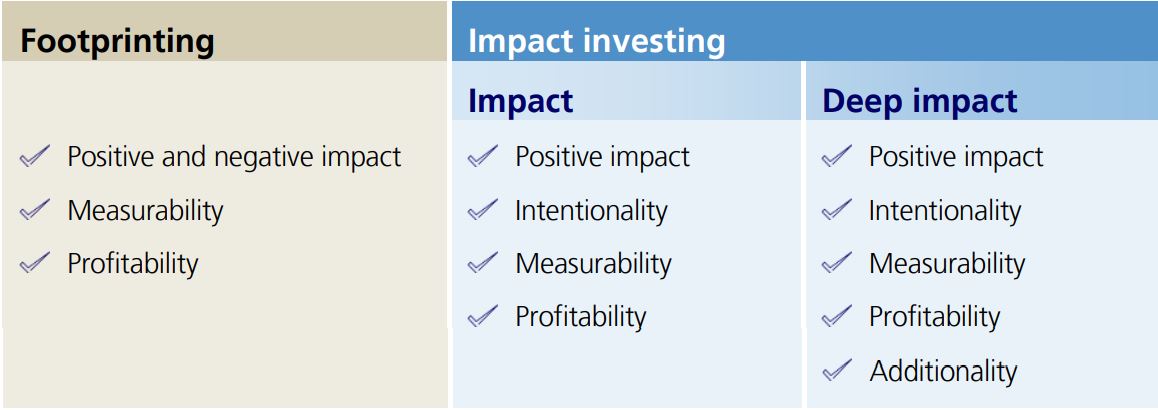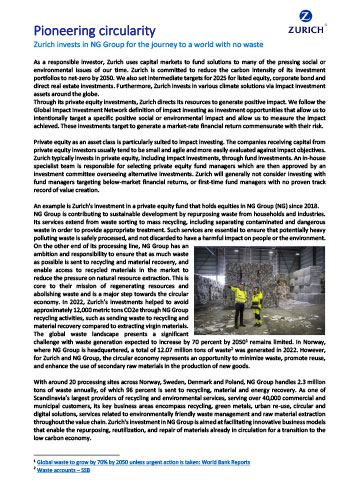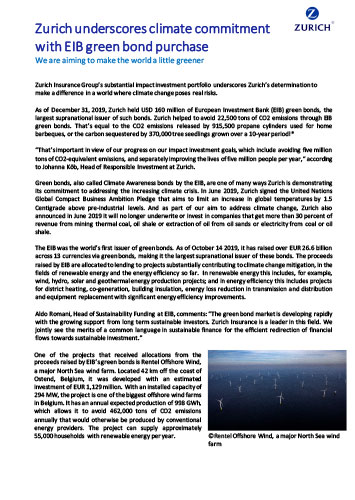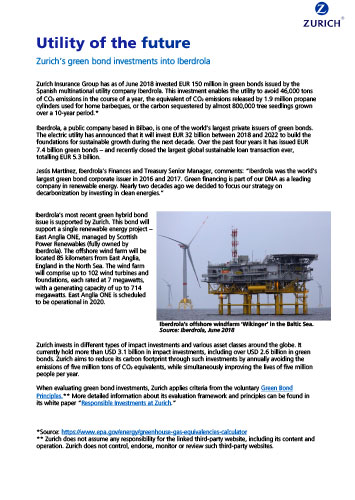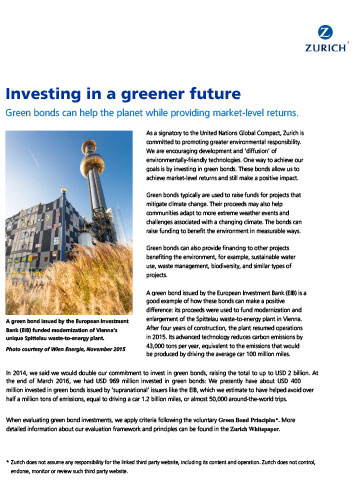
Impact investment

Impact Investing:
- Intentionality
- Measurability
- Profitability
As a responsible investor, we use capital markets to fund solutions to many of the pressing social or environmental issues of our time. Integrating environmental, social and governance (ESG) factors and excluding certain assets from portfolios manages the risks you take on. Impact investing, however, goes one step further. It covers a broad range of complex social and environmental objectives that aim to build a brighter future.
Zurich is a leading impact investor. We have a history of challenging ourselves, learning and sharing these learnings back to the market.
In November 2020, Zurich announced it had exceeded the original financial allocation target for its impact investment portfolio of USD 5 billion, and from now on will prioritize the impact this portfolio generates.
Over recent years, Zurich has developed a methodology to measure and aggregate impact across various asset classes. Measuring impact for various years has led to many lessons in how to measure and manage impact, specifically in how to interpret the impact intensities of various types of investments.
This knowledge allows Zurich to prioritize the targeted impact, allowing committed funds to follow. Zurich confirms its ambition to help avoid 5 million metric tons of CO2-equivalent emissions and improve the lives of 5 million people every year. We will build the diversified and profitable impact investment portfolio needed to meet these targets.
Defining impact investing
At Zurich, we define impact investing as investment opportunities that allow us to intentionally target a specific social or environmental impact, provide a measurable impact, and are profitable - meaning that they generate a financial return commensurate with their risk.
Zurich evaluates impact investments within the context of specific asset classes and creates dedicated strategies for impact investments within those classes. While continuing to make systematic use of ESG data in investment decision-making and valuation, we look at a variety of ways to grow our impact investment portfolios around the world. We focus on the following asset classes.
| Supranational, Government and Government Guaranteed Bonds / Corporate Credit |
|
| Private debt |
|
| Private Equity |
|
Zurich will evaluate new prospective opportunities across asset classes to broaden its approach and increase its investment volume.
Based on our experience as an impact investor, we also differentiate between investments that are aligned with increasing our impact and those which play a truly catalyzing role.
Impact measurement
At the end of December 2023, Zurich’s impact investment portfolio of USD 7.9 billion helped avoid 4.5 million metric tons of CO2-equivalent emissions and improved the lives of 4.6 million people. The portfolio includes green bonds, as well as social and sustainability bonds, and commitments to eight private equity funds active in areas such as financial inclusion and clean technology, as well as private debt impact infrastructure investments such as wind or solar farms. In 2018, we developed an impact measurement framework to track the success of our impact portfolio.
In 2017, Zurich increased its commitment to impact investments and became the first private sector investor to introduce impact targets. While committing to an overall investment of USD 5 billion, innovative impact targets were set, including the goal of avoiding 5 million metric tons of CO2-equivalent emissions and improving the lives of 5 million people per year.
In 2013, Zurich was the first investor to issue a request for proposal (RFP) for a dedicated green bond mandate. In a market of under USD 13 billion in issuance, we pledged to invest USD 1 billion in green bonds, which we later raised to a USD 2 billion target, catalyzing this nascent market.
On top of tracking our exposure and targeted returns, we want to know what each of our investments achieves in terms of impact, and to measure our contribution toward our two impact investment objectives: mitigating environmental risks and increasing resilience. Measurement helps us make better investment decisions and allows us to communicate our value to our shareholders. It also demonstrates that financial returns can be balanced with environmental and social returns. When committing to specific impact targets as one of the first private-sector investor, we deliberately choose to challenge ourselves and the market. In this way, we can together develop a common methodology, based on a standardized approach that allows us to measure impact on a portfolio level – across asset classes and underlying investment instruments.
Danielle Brassel, Responsible Investment Analyst, about the value of measuring impact (September 2020)
The measurement framework we have developed allows us to aggregate impact across the relevant portfolio in terms of two defined metrics: ‘CO2-equivalent emissions avoided’ and ‘the number of people who benefited.’ Data on emissions of greenhouse gases (generally quoted in metric tons of CO2-equivalent emissions) is a commonly used indicator to assess the climate impact of an asset as established by the IFI harmonized framework. ‘Avoided’ CO2 emissions are calculated against a baseline scenario that reflects the most likely project outcomes or level of service achieved in the higher-carbon conventions of the economy.
To measure our social objective to ‘increase resilience,’ we count the number of people who have benefited from Zurich’s investees’ services in education, housing or financial inclusion as well as other measures aimed at improving lives. When calculating ‘the number of people who benefited’, we only include those individuals who are part of a specifically targeted audience and who were previously unable to access those services.
Zurich’s framework methodology looks only at the impact created by Zurich’s share of investments and is based on the information reported by the issuers of impact investing instruments.
Zurich is well on track to achieve its targeted impact goals of avoiding 5 million metric tons of CO2-equivalent emissions and improving the lives of 5 million people per year. For more information about our impact measurement framework, read the Impact measurement methodology paper.
Impact investing KPIs
Impact measurement
Total amount of impact investments
USD 7.9CO2 equivalent emission avoided
tons 4.5people benefited by positive contribution to the lives and livelihoods
4.6Impact portfolio
| (Impact investing portfolio) | 2023 | 2022 | Change | 2021 | 2020 | 2019 | 2018 |
|---|---|---|---|---|---|---|---|
| Total amount of impact investments (USD millions) | 7,882 | 6,328 | 25% | 7,037 | 5,770 | 4,555 | 3,790 |
| Total amount of impact investments - environmental share | 73% | 73% | - | 73% | 77% | 80% | - |
| Total amount of impact investments - social share | 27% | 27% | - | 27% | 23% | 20% | - |
| Green, social & sustainability bonds (USD millions) | 6,857 | 5,247 | 31% | 5,846 | 4,677 | 3,645 | 3,104 |
| Impact private equity (USD millions) | 216 | 213 | 1% | 211 | 189 | 163 | 145 |
| Impact infrastructure private debt (USD millions) | 808 | 867 | -7% | 980 | 904 | 747 | 540 |
